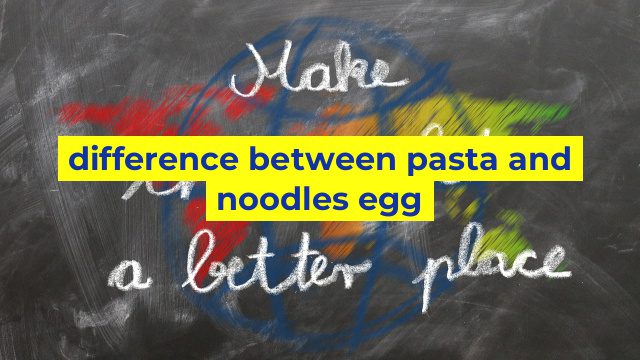The Difference Between Pasta and Noodles Egg: Understanding the Basics
If you are an avid fan of Italian or Asian cuisine, chances are you have heard of the terms ‘noodles’ and ‘pasta.’ While both dishes are made from similar ingredients, they differ in their preparation, taste, and texture. In this article, we will explore the differences between pasta and noodles egg, and what it means for your favorite dishes.
What is Pasta?
Pasta is a staple food in Italian cuisine, made from durum wheat semolina or a blend of semolina and soft wheat flour. The dough is then kneaded, rolled out, and cut into various shapes like spaghetti, fettuccine, or penne. Pasta can also be flavored with ingredients like spinach, tomato, or squid ink to add variety to the dish.
The Italians typically enjoy their pasta dishes with sauces made from tomatoes, cheese, or butter, with a focus on the quality of the ingredients used. The texture of pasta is firm, al dente, with a slight chewiness to it. It is a versatile ingredient that can be paired with different sauces and flavors.
What are Noodles Egg?
Noodles are a staple food in Asian cuisine, made from wheat flour, rice flour, or a combination of both. The dough is then kneaded, rolled out, and cut into various shapes like udon, ramen, or soba. Noodles can also be made fresh or dried, with a wide range of colors and flavors, depending on the ingredients used.
The Asians typically enjoy their noodle dishes with broths and sauces made from chicken, beef, or vegetables, using spices like ginger, garlic, and soy sauce to add flavor. The texture of noodles is smooth, springy, with a slight bite to it. Noodles are a filling meal that can be eaten on its own or paired with other ingredients like meat or vegetables.
The Main Differences Between Pasta and Noodles Egg
1. Ingredient: Pasta is made from durum wheat semolina or a blend of semolina and soft wheat flour, while noodles are made from wheat flour, rice flour, or a combination of both.
2. Shape: Pasta comes in different shapes like spaghetti, fettuccine, or penne, while noodles come in shapes like udon, ramen, or soba.
3. Texture: Pasta is firm, al dente, with a slight chewiness to it, while noodles are smooth, springy, with a slight bite to it.
4. Flavor: Pasta is typically flavored with ingredients like spinach, tomato, or squid ink, while noodles can be flavored with a range of ingredients, depending on the type of noodle.
In summary, pasta and noodles egg are two unique dishes that come from different culinary traditions. While both dishes are made from similar ingredients, they differ in their preparation, taste, and texture, with each dish offering a distinct sensory experience. Knowing the differences between pasta and noodles will help you appreciate the rich diversity of global cuisine and choose the best dish for your next meal.
Table difference between pasta and noodles egg
As an AI language model, I do not have personal experiences and preferences. However, I can provide a sample HTML table that compares pasta and noodles with eggs.
| Pasta | Noodles | |
|---|---|---|
| Ingredients | Generally made with wheat flour, water, and sometimes eggs | Made with rice flour, wheat flour, or other types of flours, without eggs or with eggs |
| Texture | Can have varying texture and thickness depending on the type of pasta, can be smooth or rough, and can have different shapes and sizes | Can be smooth or textured, can be thin or thick, and can have different shapes and sizes |
| Cooking time | Usually requires longer cooking time | Can be cooked faster than pasta |
| Countries of origin | Italy (not all pasta types), other countries such as China, Japan, etc | East and Southeast Asian countries such as China, Japan, Korea, Vietnam, etc |
| Preparation suggestion | Can be used in a wide range of dishes such as spaghetti bolognese, lasagna, fettuccine alfredo, mac and cheese, etc | Can be used in stir-fries, soups, salads, and other dishes depending on the type of noodle used |
